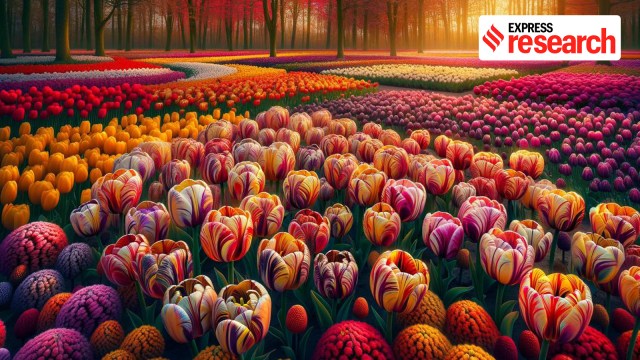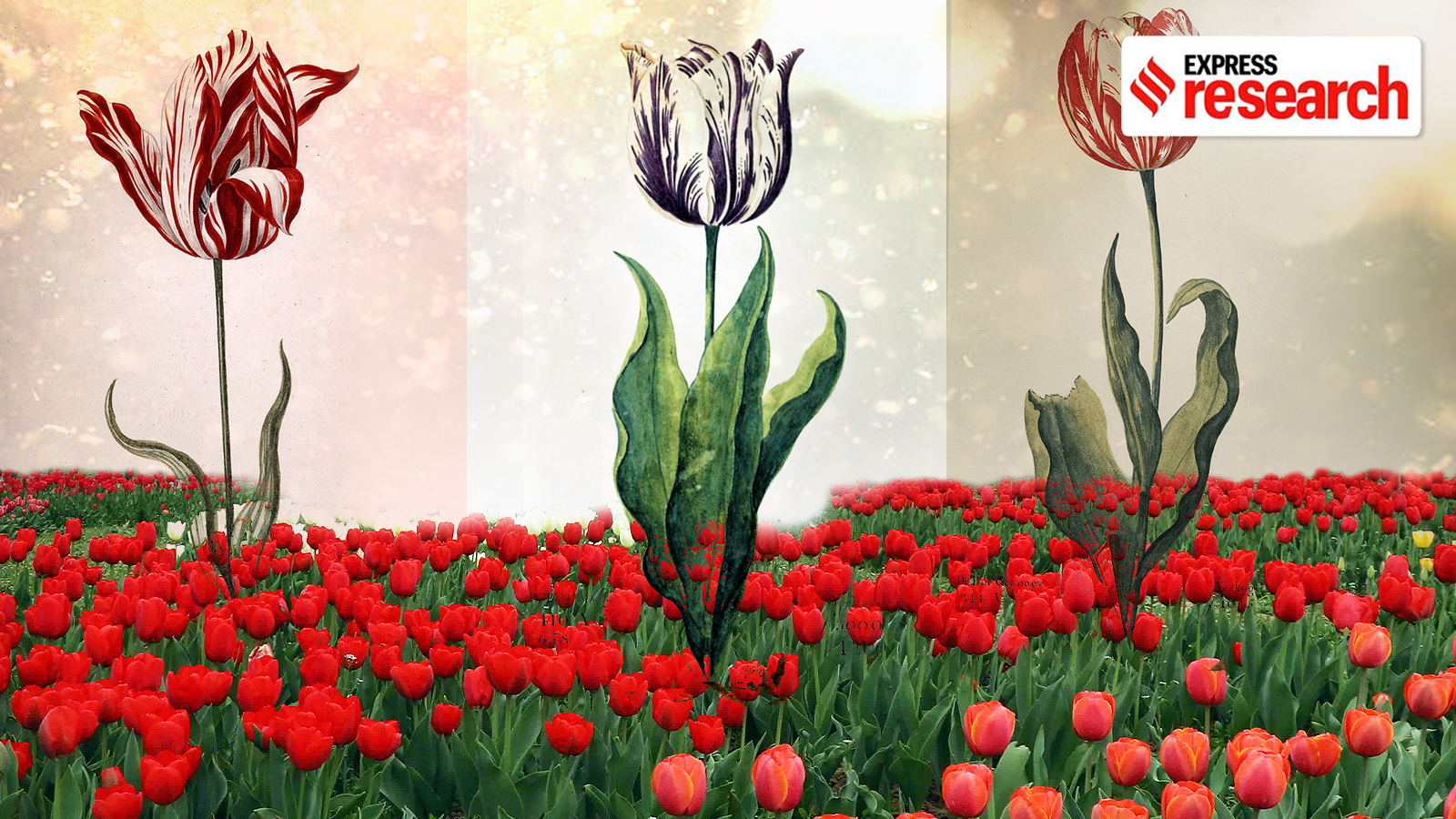- India
- International
How a viral infection led to the Dutch obsession with tulips
The recent popularity of tulips in the national capital reminds one of the frenzy that the flower had once caused in Europe, in the Netherlands to be precise. Adrija Roychowdhury finds out more about the 17th century Dutch 'Tulipomania' and the role of a virus in it.
 The frenzy over tulips in 17th century Netherlands had brought its economy to near ruin. (representational image depicting a tulip garden created by Dall-E)
The frenzy over tulips in 17th century Netherlands had brought its economy to near ruin. (representational image depicting a tulip garden created by Dall-E)Bright yellow, vibrant crimson, mauve lined with pink, red stroked with white, and more — rows and rows of tulips adorn Delhi in February. Photographers, Instagrammers and languid strollers can’t seem to get enough of the burst of spring colours that make for a stunning sight.
The recent popularity of tulips in the national capital reminds one of the frenzy that the flower had once caused in Europe, in the Netherlands to be precise. The ‘tulipomania’, as it came to be called, had shaken the entire nation and nearly brought its economy to ruins. Although tulips today are almost exclusively associated with the Netherlands, the flower did not originate here. A native of Central Asia, the tulips had been imported to the Netherlands from Constantinople. Lesser known though is the role played by a viral infection that led to the madness around tulips in Holland.
The Central Asian beauty
Tulips are known to have evolved from lilies in East Asia some 21 million years ago. It was cultivated in the western slopes of the Tien Shan mountains in Kazakhstan, extending up to central Crimea. In Kazakhstan, the flower was used as food by nomads and herders.
However, long before the flower became the exotic prized possession in the Netherlands, its beauty was already being celebrated in the East. The Persians were the first ones to remark upon the wondrous sight of the tulip from the 11th century onwards. For them, tulips marked the beginning of spring. From paintings on tiles and clothing to poetry, the Persians used tulips as a motif for grace and beauty. “In one of his most famous verses, Omar Khayyam used the tulip as a metaphor for perfect female beauty,” writes biochemist Pranay Lal in his book, ‘Invisible Empire: The Natural History of Viruses’ (2021).
Be it Shiraz, Baghdad, Constantinople, Samarkand, Peshawar or Srinagar, by the 15th century, the tulip had found its way to every city where the Persians and Turks enjoyed a presence. Replacing the more conventional flowers such as dahlias, roses and hyacinths, the tulips became the leitmotif of Islam’s vision of paradise.
 The Persians were the first ones to remark upon the wondrous sight of the tulip from the 11th century onwards. (Image edited by Abhishek Mitra)
The Persians were the first ones to remark upon the wondrous sight of the tulip from the 11th century onwards. (Image edited by Abhishek Mitra)
In the Ottoman Empire, a specific kind of tulip was in fact most valued. These were the ones with absurdly long petals, drawn to a point fine as a needle. The American author and journalist Michael Pollan in his book, ‘The Botany of Desire’ (2001) notes that “the metaphor of choice for this form of tulip petal was the dagger.” He points out that for a time in the 18th century, the bulbs of tulips that matched the Turkish ideal were traded in Constantinople for quantities of gold.

For that matter, the reign of Sultan Ahmed III from 1703 to 1730 was known to Turkish historians as ‘lale devri’ or the tulip era. Driven by mad passion for the flower, each year he would import millions of tulips from Holland that had by then become masters of large-scale tulip bulb production. The Sultan would organise an annual tulip festival, the extravagance of which is said to have ultimately led to his downfall.
Pollan in his book provides a detailed description of the Ottoman Sultan’s tulip festival. “Each spring for a period of weeks the imperial gardens were filled with prize tulips (Turkish, Dutch, Irania) all of them shown to their best advantage,” he writes. Each variety was marked with a label made of silver filigree. Further, songbirds in gilded cages were placed to provide music and hundreds of giant tortoises with candles on their backs moved around the gardens. Pollan remarks, “At the appointed moment a cannon sounded, the doors to the harem were flung open, and the sultan’s mistresses stepped into the garden led by eunuchs bearing torches.” This whole scene was repeated every night of the tulip season. The conspicuous waste of national money that was carried out to arrange this spectacle eventually ignited a revolt that led to the end of the Sultan’s rule.
The Dutch Tulipomania
It was in 1554 that the tulips were first introduced to Europe. Ogier Ghislain de Busbecq, the ambassador of the Austrian Hapsburgs to the court of Suleiyman the Magnificent in Constantinople, sent a consignment of tulip bulbs to the West. “The fact that the tulips first official trip west took it from one court to another- that it was a flower favoured by royalty- may also have contributed to its quick ascendancy, for court fashions have always been especially catching,” writes Pollan.
Carolus Clausius, the man who brought the tulip to the Netherlands, was known to be one of the greatest botanists of his time. He is credited with the introduction and spread of hyacinths, lilies, narcissi among others across Europe. He first encountered the tulip during a trip to the Iberian Peninsula in the 1560s. From there he brought a cartload of tulip bulbs to the court of Maximilian II of Hapsburg-Austria.
In 1573, Clausius was commissioned to design the royal gardens in Vienna, where the tulips were to find a most special place. However, on being dismissed by Maximilian II’s successor Rudolf II in 1577, he left for Holland with his tulip collection. There he created Holland’s first bed of tulips at a nursery in Leiden University in 1593. Being close to aristocrats and merchants, it was not too difficult for Clausius to make the tulip an object of desire that spread far and wide all over the Netherlands. In a matter of two decades, by 1620, tulips became the most prized possession in almost every house and garden of the Netherlands. “Tulips were perhaps the first living plant to become central to the drawing room,” writes Lal. “They were planted in expensive Chinese and decorative Deft porcelain vases, and in Venetian crystal bowls placed on windowsills and lined up on porticos and anterooms.”
The horticultural writer Anna Pavord in her book, The Tulip (1999), writes that among rich merchants of Holland in the 17th century, fountains, aviaries of rare birds, and temples in the Greek style were standard accouterments of the garden.“But the tulip was the ultimate status symbol, the definitive emblem of how much you were worth,” she writes. Those who could not afford the flower themselves commissioned the greatest among the Dutch artists to paint tulips for them.
It was inevitable perhaps that tulipomania also brought tulipophobia in its wake. Pavord in an email interview with indianexpress.com points to the story of the professor of Botany at Leiden University who grew to loathe tulips. So much so that he “attacked them savagely wherever they stood, thwacking them soundly with his cane.”
 A 19th century painting depicting Tulip Mania, by Johannes Hinderikus Egenberger (Wikimedia Commons)
A 19th century painting depicting Tulip Mania, by Johannes Hinderikus Egenberger (Wikimedia Commons)What explains this Dutch obsession with a flower? explains that “it was partly a matter of timing,” explains Pavord. “The Dutch East India Company had been set up in 1602 and this, combined with Amsterdam’s increasing importance as a port, marked the beginning of an era of great prosperity for the Dutch. Merchants got rich and in their wake, lawyers, doctors, pharmacists and jewellers too,” she says.
Pavord explains that the Dutch, the superb marketeers they were, were “quick to recognise new markets, such as the US, where Dutch and German immigrants were establishing new communities in Pennsylvania and Ohio. Six hundred different kinds of tulips were bedded out on Long Island in the spring of 1845.”
Pollan in his book notes that in the 17th century, the Dutch were the richest people in Europe and did not shy away from indulging in the conspicuous display of wealth. It must be noted that up until then, flowers in Europe were valued only if they served some utilitarian purpose. As observed by Pollan, when the tulip first arrived in Europe, people went about finding ways to make it useful. The Germans, for instance, boiled and sugared the bulbs and declared them a delicacy, though they were not successful. The English too tried to turn them into edible products. That too failed.“The tulip was a thing of beauty, no more, no less,” writes the 20th century poet Zbigniew Herbert in his celebrated essay on tulipomania, ‘The Bitter Smell of Tulip’. The tulip’s uselessness though was precisely what suited the Dutch taste of extravagance.
The mysterious role played by a virus
While acquiring the most beautiful tulip became the latest fad in 17th century Netherlands, it was the variegated kind that was most in demand. “The flower had a unique trick that dangerously added to its other attractions,” comments Pavord. “It could change colour seemingly at will. A plain red tulip might emerge the following spring in a completely different guise, the petals feathered and flamed in intricate patterns of yellow.”
“Each tulip would look different and have a personality and beauty of its own,” Lal tells indianexpress.com. “This was unlike any other flower like the marigold or chrysanthemum, which in a bunch would all look alike.” It is the magical and unpredictable nature of tulips that drove up its prices.
Lal in his book observes that “like art, the price of tulips was driven by whim, wealth and outright greed.” “A single bulb once sold for the price of a sailing ship laden with exotic goods from the East Indies. A pot with two bulbs of ‘broken’ tulips could fetch as much as a hundred times the salary of a skilled craftsman. A bulb of a very rare tulip could pay for five commissioned paintings by Rembrandt.”
 A representational image of the global obsession over tulips created by Dall-E
A representational image of the global obsession over tulips created by Dall-E
Pollan in his book notes that if a tulip broke in a particularly striking manner, for instance, if the streaks and stripes were perfectly symmetrical, the owner of the bulb would have won a lottery. They would command a fantastic price. “The fact that broken tulips for some unknown reason produced fewer and smaller offsets than ordinary tulips drove their prices still higher,” he writes, noting that the Semper Augustus tulip was the most famous among such breaks.
Though tulip lovers did not know it back then, these breaks in colours were being caused by a virus. Up until the 1880s, the word ‘virus’ was not understood in the modern sense at all. It was as late as the 1920s and after the invention of the electron microscope that researchers began to unravel its true nature. Until then, tulip growers came up with ingenious ways and means to cause vibrant bursts of colours. “Some, taking cue from contemporary alchemists, laid powdered paint on their tulip beds, expecting the colours miraculously to affect the flowers,” remarks Pavord.
The insane demand for broken tulips led to a near catastrophe in the economy of Holland by 1637. By the mid-1630s, trading and speculation over tulips were common in taverns and backrooms. Just before the spring blossom of 1637, rumour was rife of particularly wondrous streaked tulips to hit the market. Traders advised their clients that such streaked tulips would be very few in number and hence would fetch a very high price. However, what occurred thereafter was the complete opposite. The speculators were proven wrong and by March an abundance of broken tulips had flooded the Dutch markets.
Consequently, the prices started dropping drastically, bringing ruin to traders and ending the phase of ‘tulipomania’ in Holland. Lal points out that it was only much later in the 1980s that scientists came to understand how ‘breaking’ was happening in tulips and affecting its petals. The virus responsible was known as potyvirus, which was spread by aphids commonly found in plants like plum, peach and potatoes. “It was a chance encounter that in 17th century Holland, tulips were being grown in close proximity to these plants. So the virus found a new plant to infect,” says Lal.
In his book, Lal explains that when the virus infected the tulip plant, it suppressed the production of a dominant pigment called ‘anthocyanin’ in the flower’s petals but left the base colour unchanged. “Each viral infection creates a unique and different type of streaks, stripes, feathers and flames because of the irregular distribution of anthocyanin in every petal,” he writes.
Once cultivators understood that the beauty of the broken tulip was caused by a virus, they no longer planted them in their gardens and fields, because of the fear of the virus destroying agricultural crops and other tulips as well. “The botanical societies of the world decided that only those tulip plants that are virus-resistant would be planted and that they needed to stop this viral infection in species,” says Lal.
Although ‘tulipomania’ among the Dutch was never replicated, they did resume cultivation of tulips in the early 20th century, becoming the largest producer of the flower over time. At present, the global market is dominated by the monotone Darwin tulips and strict sanitary procedures are followed to ensure there are no viral outbreaks. One can still occasionally come across tulips though that stand out for the streaks and stipples of colours on them. These, as Lal explains, are caused by genetic variation and not a viral infection.
 The Tulip festival in New Delhi (Adrija Roychowdhury)
The Tulip festival in New Delhi (Adrija Roychowdhury)
The modern-day tulip festivals are inspired by the flower’s Dutch connection. “It was the clever Dutch who turned the tulip from a “jewel” flower into a flower for bedding out en masse,” says Pavord. Apart from Amsterdam, tulip festivals are held in most parts of the world where a Dutch historical connection existed. One of the largest tulip festivals in the world for instance takes place in Ottawa, Canada where the Dutch royal family had sent tulip bulbs as a gift for the assistance provided by the former during the Second World War.
In India, where also the tulip festivals have become an annual affair, the Dutch have had a long historical presence as traders and colonisers. Pavord points out, indigenous tulips can be found in the wild in India too. “But I doubt the festival being planned for New Delhi will be of indigenous wild tulips,” she says. “However, India has such a wealth of wonderful plants of its own, I wonder why it needs to turn to tulips for a festival.”
Further reading:
Anna Pavord, ‘The Tulip’, Bloomsbury Publishing Plc, 1999
Pranay Lal, ‘Invisible Empire: The Natural History of Viruses’, Penguin Viking, 2021
Michael Pollan, ‘The Botany of Desire: A Plant’s Eye View of the World’, Random House Publishing Group, 2001
Apr 05: Latest News
- 01
- 02
- 03
- 04
- 05








































